Helpdesk ticketing software can provide your support team with needed features and help them perform at their best. Or it can overcomplicate their workflows and create confusion.
There’s no one best helpdesk for everyone. For example, while they have a lot to offer, ‘enterprise’ solutions may not speak to the needs of your small business. What your team requires is an easy-to-use, intuitive platform that feels comfortable.
In this post, we’ll take a look at eight popular tools and discuss what value they provide. We’ll talk about use cases, scalability, ease of use, and more – so you can find the right helpdesk ticketing system for your small business.
What To Look for in a Small Business Helpdesk Ticketing System
If your support team is looking to switch from a standard mailbox (like Gmail or Outlook), the amount of helpdesk solutions out there can seem overwhelming. What functionality do you need, and what is just marketing hype?
There are definitely features your support team can’t work effectively without, such as a shared inbox. At the end of the day, however, the majority of helpdesks offer similar core functionality.
As for the more advanced features, they’re rarely relevant to your business. Helpdesks are often built to offer as many bells and whistles as possible, and are designed for the needs of large corporations.
The point is that it’s better to focus on the intangibles. What’s the best helpdesk ticketing system for your small business? The one that offers an intuitive, easy-to-use solution at an affordable price.
With that in mind, here are a few aspects to focus on when evaluating any helpdesk ticketing system.
Intuitive User Interface
First ask yourself: Is the software easy to use?
Any new tool will require an adjustment period. Nevertheless, it should be easy for your team to pick up and dive in without feeling overwhelmed.
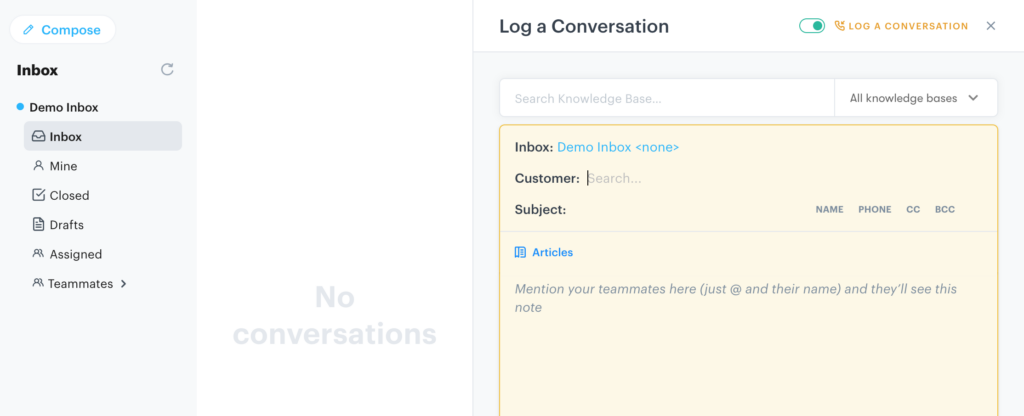
How can you identify a user-friendly helpdesk ticketing system for small business? Check to see if it meets the following criteria:
- The options your team is most likely to use are easy to find, clear, and accessible.
- If you need to assign a ticket or create a tag, you can do so easily from the dashboard.
- The system works quickly and smoothly – no friction, lag, or unclear navigation.
- You can customize the helpdesk to match your existing (or desired) workflows.
- Tools and resources are integrated into the inbox in a seamless (and well-explained) way.
Smooth Onboarding Process
A white-glove onboarding process can eliminate friction, and make adopting a new helpdesk simple. It’s important for your team to understand what the most relevant features and use cases are for their needs. They may also need support while learning the more complex parts of the tool.
In other words, the developers behind the helpdesk you choose should provide a seamless onboarding experience. That can be rare, since it’s not easy to do well. Here at Groove, we’ve learned a lot over the years about how to improve our own onboarding process to give new users what they need.
Keep an eye out for easily-accessible resources like:
- In-app walkthroughs to help you navigate key features and tools
- Product demos or live training sessions
- Multiple 24/7 support channels
- Self-serve resources such as FAQs and knowledge bases
Third-Party Integrations
Integrations might not be necessary for a business that’s just starting out. But as you grow, you’ll likely start using additional tools to communicate, collaborate, report bugs, and track customer data.
The need to juggle various platforms can become real headache. So don’t forget to take a look at what integration options each helpdesk ticketing system offers. It should work well with popular third-party apps your business uses now or may adopt down the road.
Security and Compliance
Security is especially important for a helpdesk. There’s a lot of sensitive customer information involved, and that data may need to be shared across various communication channels.
To start, you’ll want to look for tools with role-based permissions options. This lets you limit user access where appropriate – customer details should be on a ‘need to know’ basis.
A quality helpdesk ticketing system for small business should also offer Two-Factor Authentication (2FA) login, to prevent unauthorized access. Depending on your business type and location, you may need a solution that is GDPR or HIPAA compliant.
Finally, the company behind your helpdesk should be transparent about its servers and hosting providers.
Reporting and Metrics
Tracking your support team’s progress is key to providing top-quality customer support. This process is a lot easier with access to the right metrics, reports, and survey tools.
Quantitative and qualitative data verifies the quality of your support, and gives you the information you need to improve. So the right helpdesk ticketing system for your small business should make key performance metrics easy to track and understand.
Look for reporting features that are available in a centralized dashboard. It’s also useful to have automated, customizable reports that can be exported as needed.
Collaboration Features
Even if there are only a few people on your support team, they’ll need collaborative features. Fast and effective communication makes a huge difference. So does the ability to assign inquiries to the right places, and work together on complex issues.
A helpdesk that supports communication will provide features like:
- Internal note and @mentions, to allow for private discussions about customer concerns and potential solutions
- Collision detection, so team members can see when someone else is working on the same ticket
- Email templates or instant replies that can be used to quickly respond to common inquiries
- Ticket assignment to specific team members, including auto assignment based on workflow rules
8 Popular Helpdesk Ticketing Systems (And What They Offer for Small Businesses)
Choosing the right helpdesk is all about finding the right match between the software and your business’ priorities. To make that search easier, let’s take a closer look at eight top helpdesk ticketing solutions.
Along with the criteria we’ve already discussed, our number-one tip is to try it before you buy it. How a helpdesk feels to use matters, so we recommend trying out your favorites via demos or free trials.
1. Groove
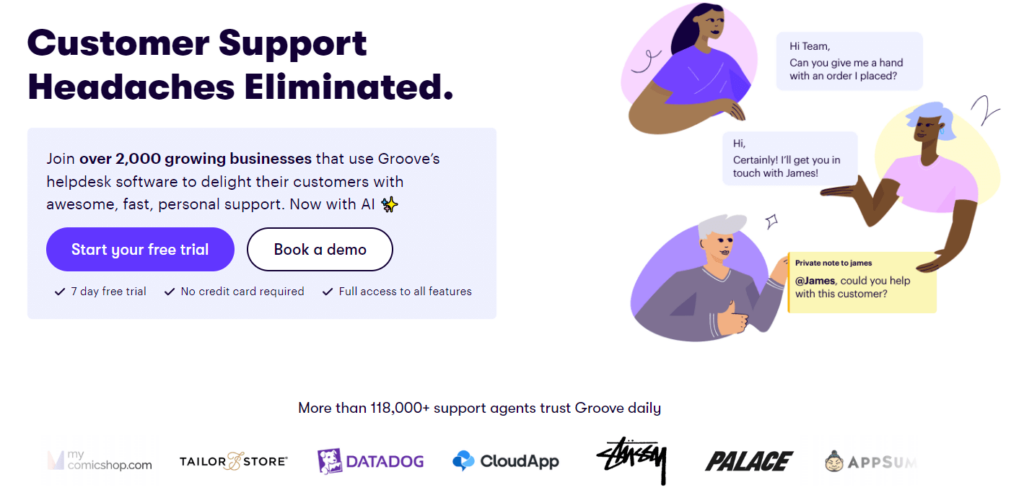
At Groove, we place a high value on simplicity and ease of use. So often helpdesks are confusing, overcomplicated, or simply overkill for many users.
That’s why we built our own helpdesk ticketing system for small businesses! Groove forwards emails from multiple Gmail or Outlook addresses into a shared inbox, so you can keep customer communications organized. It enables your support team to rapidly respond across various channels, all in one place.
Key Features
- Ticket assignment, internal notes, custom smart folders, conversation tags, and open tracking to see if a ticket has been read by the recipient
- Automation and workflow features such as instant replies and rule templates
- Internal notes and @mentions
- AI writing assistance, email summary, sentiment analysis, and drafts
- Live chat widget that can be managed directly from the helpdesk
- Call logging directly in Groove, and phone call integration via JustCall
- iOS and Android apps to manage conversations on the go
- Customer satisfaction ratings (CSAT) and survey integration
- Customizable reports on key metrics
- 40+ native integrations, with advanced options through API, webhooks, and Zapier
User Experience
Groove is an all-in-one solution, simplifying support with a shared inbox. You can route all of your Instagram DMs, Facebook messages, and Gmail/Office 365 emails right into Groove. There’s no paywall for essential integrations.
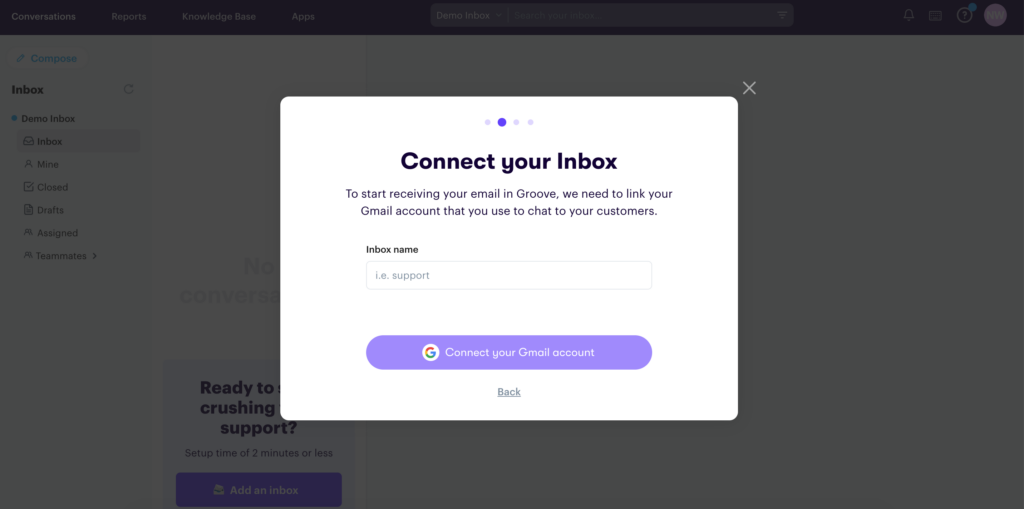
It’s very easy to set Groove up, connect your support emails, and get to work. We’ve kept things streamlined so the adjustment process is brief, and your customers won’t even notice anything has changed.
There are plenty of automation and workflow features that you can customize to match your preferred workflows. More recent additions like AI writing assistance and sentiment analysis have gotten great feedback from our users.
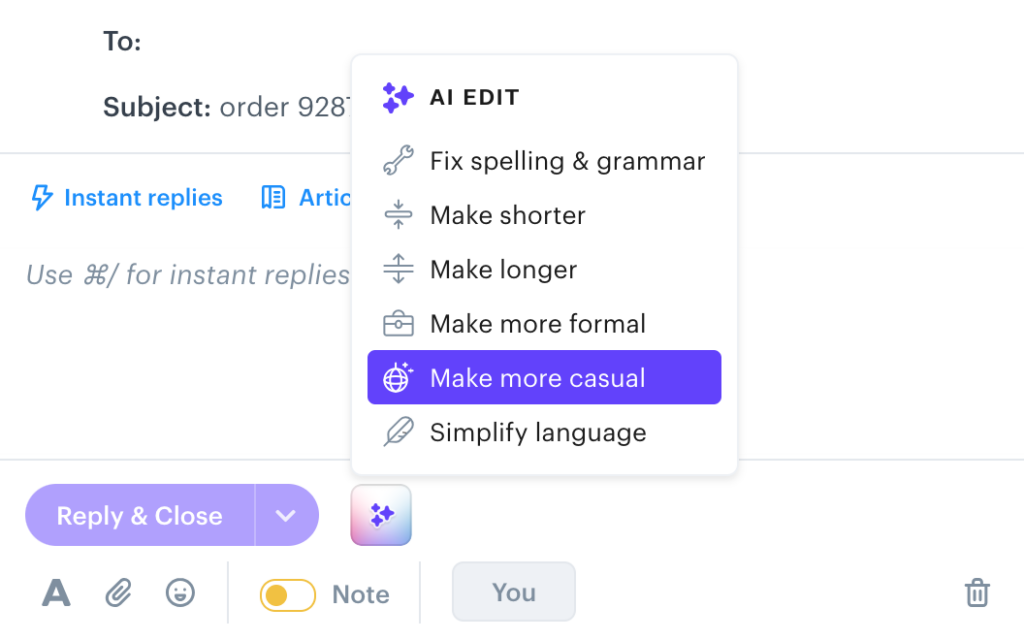
In a nutshell, Groove makes life easy for both your support team and your customers. You can cut down on busywork by creating a 24/7 self-serve knowledge base, and use a live chat widget to respond to concerns ASAP.
Scalability
Groove is built as an affordable small business tool. We offer low-cost plans if you’re just getting started, but we also keep scalability in mind. Multiple pricing tiers let you pay for only what you want, and increase your helpdesk’s capacity and feature set as your needs scale.
There are also plenty of integrations to support your business as it grows and expands, including Salesforce, Zapier, and Jira. If you need it, you can even get advanced API access, allowing for more high-level customization.
Customer Support
Of course, we think Groove is pretty great 🙂 But don’t take our word for it!
Our customers’ reviews reaffirm the value we’ve placed on delivering inclusive customer support for all users. You can contact support directly, or check out our comprehensive knowledge base for all kinds of tips and tricks.
Feature requests are taken seriously, and we’re always making updates and improvements. From onboarding through implementation and long-term use, we’re here to help your own support team succeed.
Who Is It Best For?
Groove is designed as a helpdesk ticketing system for small online business. It might be the perfect fit if you:
- Manage a support team at a small online company, and need a way to communicate and collaborate effectively
- Are currently managing customer emails through Gmail or Outlook, and want a more dedicated tool that still feels familiar
- Are using an over-complicated helpdesk that lacks user-friendly features, and need something more streamlined and purpose-built
- Have a growth-focused business – Groove can support your team as it is now and as it expands over time
We’re biased, of course, but we’re also confident that our product speaks for itself. Sign up for a free trial, and see how easy it is to use!
2. Hiver
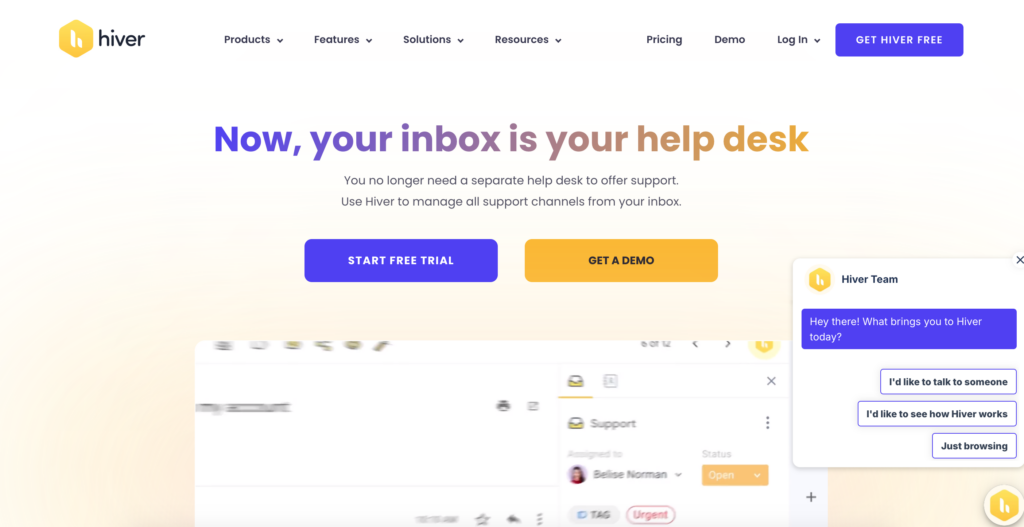
Hiver functions as a Gmail extension within your pre-existing Google workspace. Your inbox becomes your helpdesk – no fuss required.
Since it operates within a workflow that’s already familiar (assuming you use Gmail), there’s not much of a learning curve involved. Hiver is designed for small-scale businesses and favored primarily by startups.
Key Features
- Automated workflows for repetitive tasks like assigning emails or tagging them
- Two shared inboxes with up to ten users per inbox
- Team collaboration tools: collision detection, shared drafts, and cross-team communication
- Rule-based automation for routing emails based on keywords
- Native integrations: Aircall, Asana, Jira, QuickBooks, Salesforce CRM, Slack, etc.
- Round robin assignments for even workload distribution across your support team
- AI for automated templates and ticket management
- App for iOS and Android
User Experience
When it comes to ease of use, Hiver does very well. If you’ve ever used Gmail in any capacity, there’s not much you’ll need to learn.
On the other hand, it’s a bit limited in terms of native integrations. Depending on the scale of your customer support team and what tools you use, Hiver might complicate (or limit) your workflows.
There are some workarounds. For example, you can create a connection between Hiver and other apps with Zapier. Alternatively, custom integrations that your team needs for specific workflows can be added through Hiver’s own API.
Scalability
As a result of limited third-party support, Hiver might not be the best solution for businesses that use multiple tools. On the other hand, if you’re looking to manage only email communications, you’ll find Hiver a lot more beneficial than relying on Gmail alone.
Provided that your business is in a suitable niche, Hiver can scale with your business as it grows. It offers enough features via automated workflows and widgets that it doesn’t feel restrictive. Just keep in mind that there is a lack of advanced reporting features.
Who Is It Best For?
Hiver is best for users who value simplicity, and who:
- Focus on email-driven support via Gmail
- Manage straightforward communications that don’t involve technical troubleshooting or bug tracking
- Would rather avoid learning a new platform
- Are in the market for a lightweight and low-cost solution
3. Front
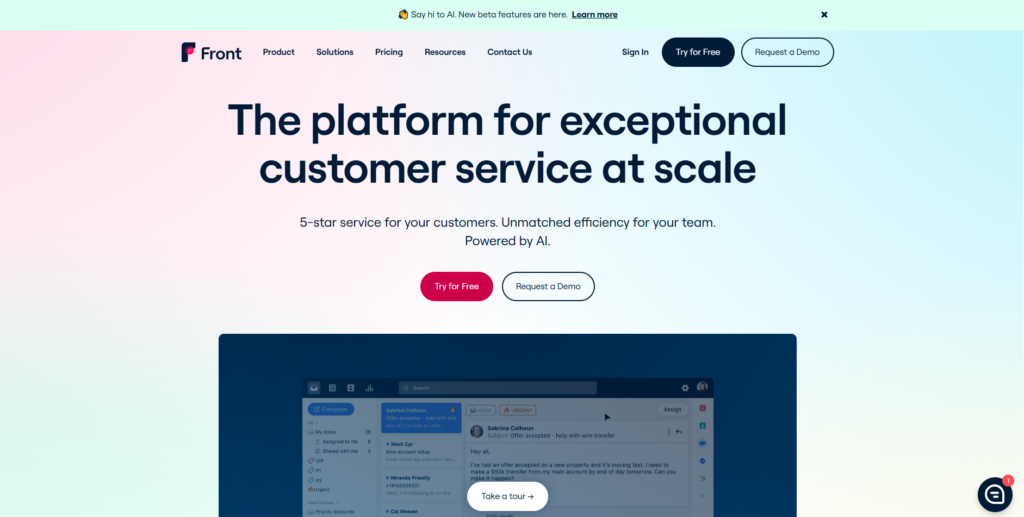
Front places a heavy focus on optimized customer communication. It’s a powerful tool that comes with a reasonably steep learning curve.
There’s a basic starter plan, although it’s fairly restrictive. Even as a startup, you’ll likely need to opt into the Growth or Scale plans to get what you need. If you do, though, you’ll be treated to an intuitive and rich customer support tool.
Key Features
- Integrations with Asana, Trello, Salesforce, etc.
- Unified shared inbox for managing multichannel communication
- Call center management
- Live chat function
- Comprehensive reporting and analytics that can be exported
- AI chatbot widget that sources answers from your knowledge base
- Context and overview for email threads
- AI email drafts, templates, and tone correction
- Ticket categorization with tags, round robin assignment, smart rules, and macros
User Experience
There’s plenty of praise for Front across various review platforms. Personally, we also liked the collaboration tools, unified SMS integration, and connectivity to tools like Pipedrive.
When we tried it out, we noticed that internal collaboration on tickets felt more like a live chat versus ‘leaving notes’. Front is a little like combining your customer service tool with a communication platform such as Slack.
In fact, unlike with most helpdesks, Front really shines when used for internal communications. While it’s not our focus here, Front is a strong option if you want a tool to organize and manage conversations between team members and departments.
Scalability
Front is certainly scalable, and offers an impressive enterprise solution for large organizations that need more than fifty seats.
Most of the advanced features Front offers are restricted to those more expensive plans. So it’s less ideal for starting small and building up, and more valuable if your support team is already quite large.
Who Is It Best For?
We’d recommend checking out Front if you’re:
- A rapidly-growing business with a large customer support team
- Looking to set up highly-customized workflows and automations
- In need of a helpdesk-style tool for intercompany communications
4. Jira
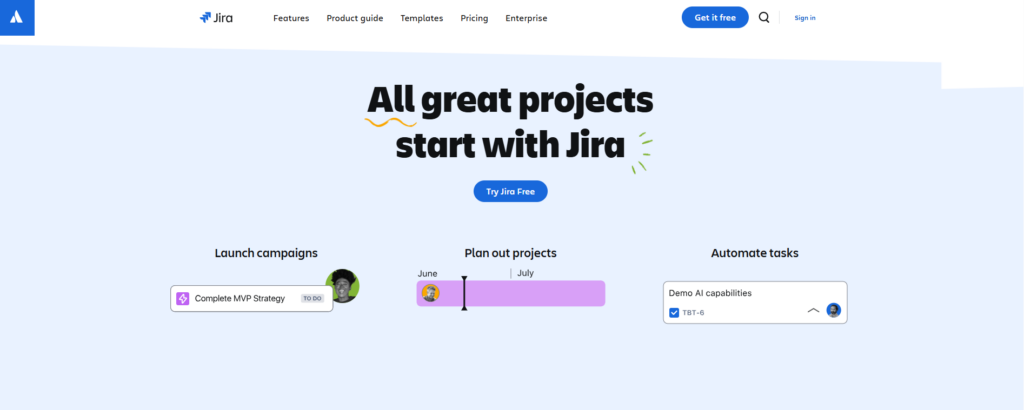
Jira was designed as a technical support desk for bug tracking, with visual scripting and clear workflows in mind.
As a platform primarily used for issue tracking in IT departments, Jira can help your team ditch spreadsheet and email communication. It offers centralized ticketing and no-code configurations to solve internal tech issues.
Key Features
- Streamlined IT support internally or externally
- Easy-to-create agile dashboards to track bugs
- Data extraction for user-specific tickets
- Advanced business workflow for software development, incidents, or service requests
- Integration with hundreds of tools, including Confluence
- Purpose-built templates
- Automation features
- Data tracking and metric reports that can be exported
User Experience
Jira allows for effective real-time task management and fluid work operations via advanced issue tracking, project management, 400+ pre-designed form templates, and a customizable calendar. When combined with other tools in the developer’s ecosystem, it allows an IT department to fully plan, track, and develop software.
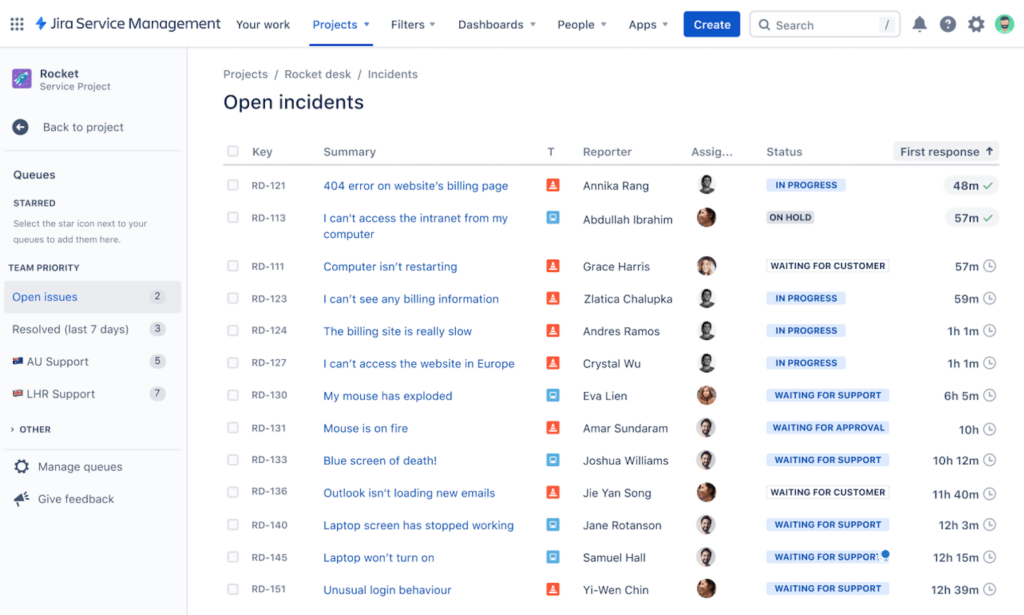
While we love the features Jira offers, the software isn’t as user-friendly as most competitors. Navigating, understanding, and configuring the features takes some practice, and requires leaning on in-depth tutorials or thorough onboarding.
Scalability
Jira is definitely scalable as a helpdesk ticketing system for small business, with plenty of features designed to support larger organizations. You can easily track and monitor ongoing service tickets or internal issues.
Still, we’d recommend it primarily to businesses looking to enhance feature or product development. It’s more ideal for internal communication and bug tracking than for customer support.
Who Is It Best For?
Jira is best for:
- Large organizations (especially if you use or plan to use other Atlassian software)
- IT departments that want an internal ticketing system
- Technical departments that want to track bugs, tech issues and/or product development
- SaaS businesses that need to route customer concerns/technical issues to internal departments and monitor them from one application
5. HelpDesk
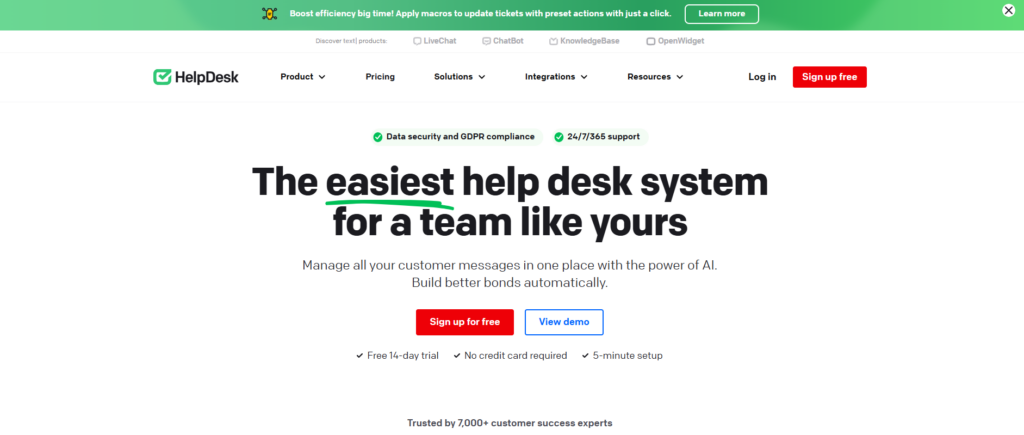
HelpDesk is a web-based solution primarily geared towards IT departments and B2B applications. It has the most difficult helpdesk name to Google accurately – no contest.
As a helpdesk ticketing system for small business, HelpDesk offers advanced workflow features that make it suited to complex use cases. There are plenty of automation rules you can customize to streamline operations, escalate issues when appropriate, and route tickets to the best agents.
One particularly nice HelpDesk feature creates a “VIP” priority for your best clients’ tickets, and automatically escalates them. You can then assign success case managers or team leads to monitor resolution of those tickets.
Key Features
- Advanced AI features, including ticket summaries
- AI text enhancements to optimize tone (polite, formal, or casual)
- AI grammar & spellcheck
- Custom automation, with templates to set up pre-designed workflows
- Automation rules based on sets of conditions and actions
- A/B email template testing
- Branded email templates with no coding required
- Macros, ticket assignment, canned responses, automation rules, tags, and custom fields
- Quantitative data tracking with reports and weekly summaries
- Data-rich ticket details, including customer relationship and ticket history
User Experience
Overall, despite its many features the HelpDesk UI is clear and easy to navigate. There’s certainly a learning curve involved, but when it comes to high-complexity helpdesks, this one is as approachable as it gets.
The heavy reliance on AI also helps. AI features point you in the right directions, suggest additions to your emails, help you create self-service articles, and so on. It’s one of the better applications of AI technology that we’ve seen in a helpdesk ticketing system for small business.
Scalability
HelpDesk offers a lot of features centered around scalability. Those include the ability to export reports, data-rich ticket details, and extensive API docs.
There are also Zapier integrations available to help you build out a tech stack via an internal IT department. It’s more than you’ll need if you have a handful of support agents, but if you’re already mid-sized and growing rapidly, it’s a great fit.
Who Is It Best For?
HelpDesk is designed for:
- Businesses and support teams that want to set up very specific workflows
- Teams that heavily rely on automation, tagging, and routing
- Small SaaS businesses with complex use cases that require advanced customization and data tracking
6. LiveAgent
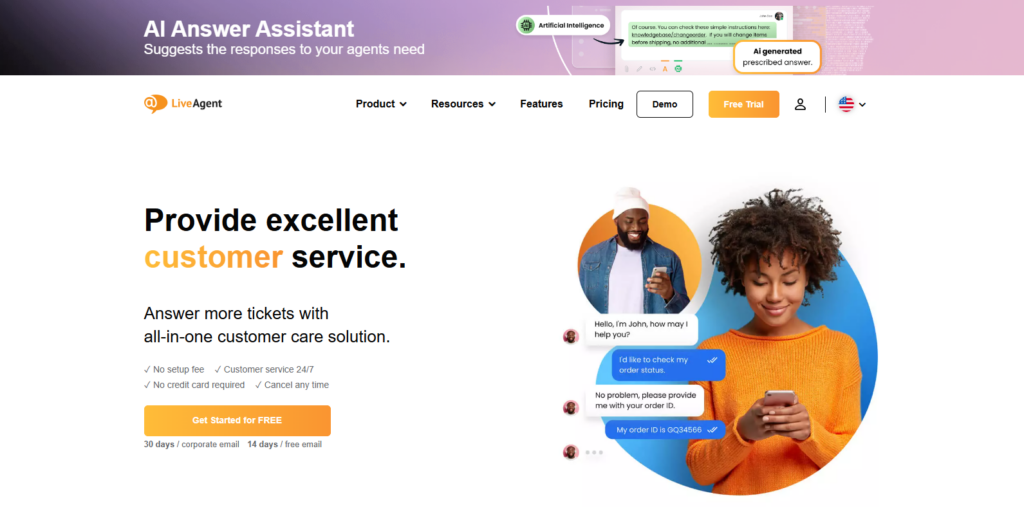
LiveAgent is a cloud-based helpdesk ticketing system for small business with plenty of integrations. It’s also under constant development, with some interesting new features in the pipeline (such as an AI assistant).
This particular helpdesk aims to strike a balance between beginner-friendly design and depth of functionality. It promises a quick setup, along with access to over a hundred ticketing features.
Key Features
- Automation rules for tagging, assigning, and responding to inquiries
- Google Maps API integration to see where your customers concentrate geographically
- Knowledge Base, FAQ, forum, and contact form creation
- Live chat support integration with your website
- Phone call integration through its own call center
- Ticket prioritization based on SLAs, mass actions, and custom tags
User Experience
LiveAgent’s UI isn’t the easiest to navigate. The design can feel counterintuitive, and the interface is functional but not really built with usability in mind.
The features are there, but it takes some time to figure out how to use them optimally. So it’s not a quick fix for streamlining your support team’s workflows. But with enough time investment, it does have a lot to offer.
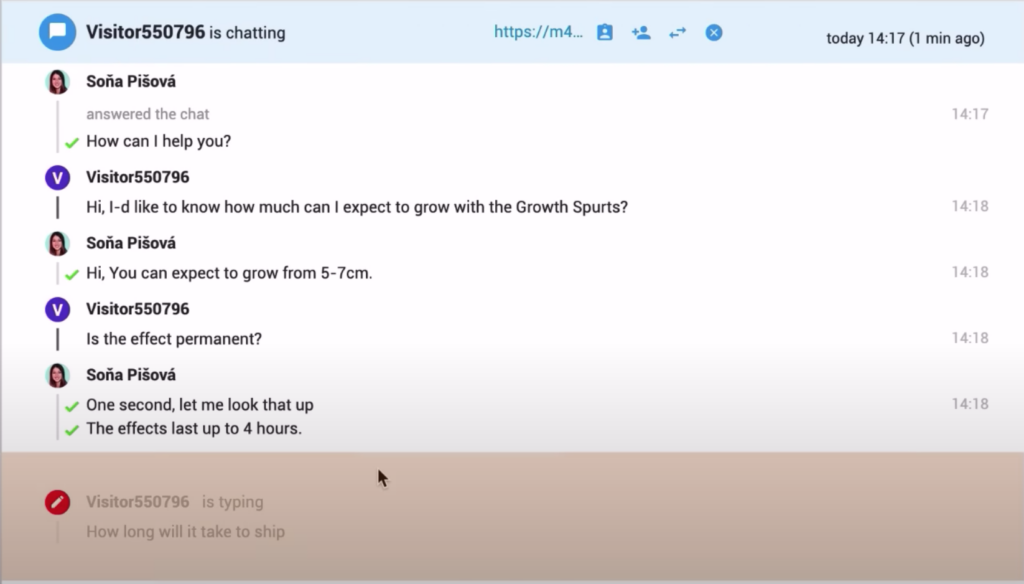
One feature we really enjoyed was the live chat widget. While this is a common helpdesk feature, LiveAgent’s version is one of the most responsive we’ve seen. This platform also offers a lot of data that you can dig into and leverage elsewhere, such as information about user demographics and detailed chat histories.
Scalability
LiveAgent is very scalable. Unfortunately, a lot of basic features are locked behind the more expensive plans. Reports, surveys, phone call integration, AI assistance, time tracking, and social media integration are all restricted.
The pricing system is also not particularly clear. For example, you can aggregate inquiries from social media platforms like Twitter, Instagram, and Facebook into your support inbox. But doing so costs an additional monthly fee per channel. So it’s best to do some digging and make sure you’ll get access to everything you need (or are willing to pay for it).
Who Is It Best For?
You might want to check out LiveAgent if you:
- Focus primarily on live chat
- Are in the market for a helpdesk with lots of advanced features (and willing to pay a premium for them)
- Want your helpdesk to double as an analytics platform with in-depth information about your users
7. Zoho Desk
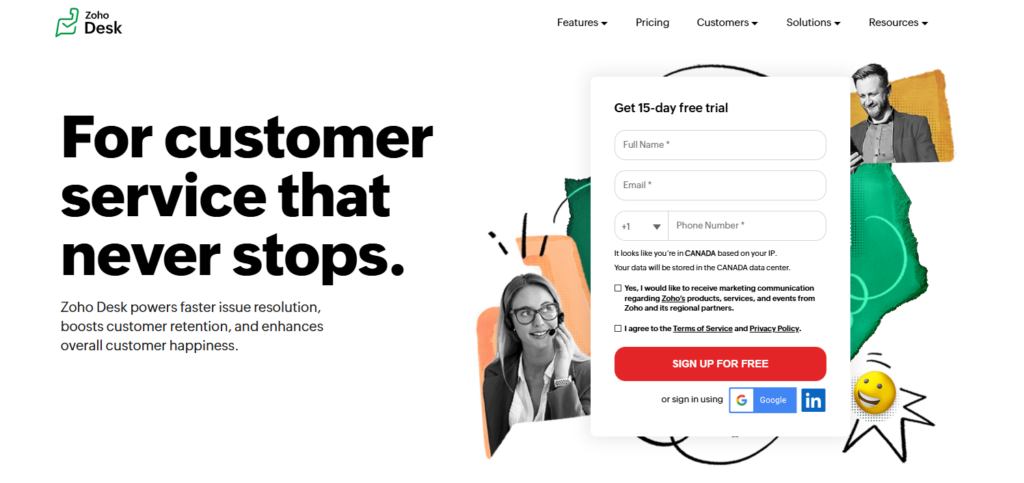
Zoho Desk is a cloud-based helpdesk solution focused on SMBs. One of the nice things about this particular platform is that it’s ready to go right out of the box. Once you’re signed in, it’s easy to set up and has all the functions you need (and expect) out of a helpdesk system.
Key Features
- Custom and pre-defined reports that can be exported to CSV, PDF, or XLS
- Custom analytics dashboards
- Response, resolution, and FCR dashboards
- Customizable email templates, macros, workflow rules, time based rules
- Ticket management features including tags, ticket assignment, overview, ticket history, product-based tracking, etc.
- Customer-based SLA
- Auto collision detection
- Round-robin ticket assignment for load balancing
- Email, web form, contact form, live chat, WhatsApp, and social media channels
User Experience
Zoho has a reputation for being easy to navigate and learn, with a clean UI. When giving it a try ourselves, we found that to be true.
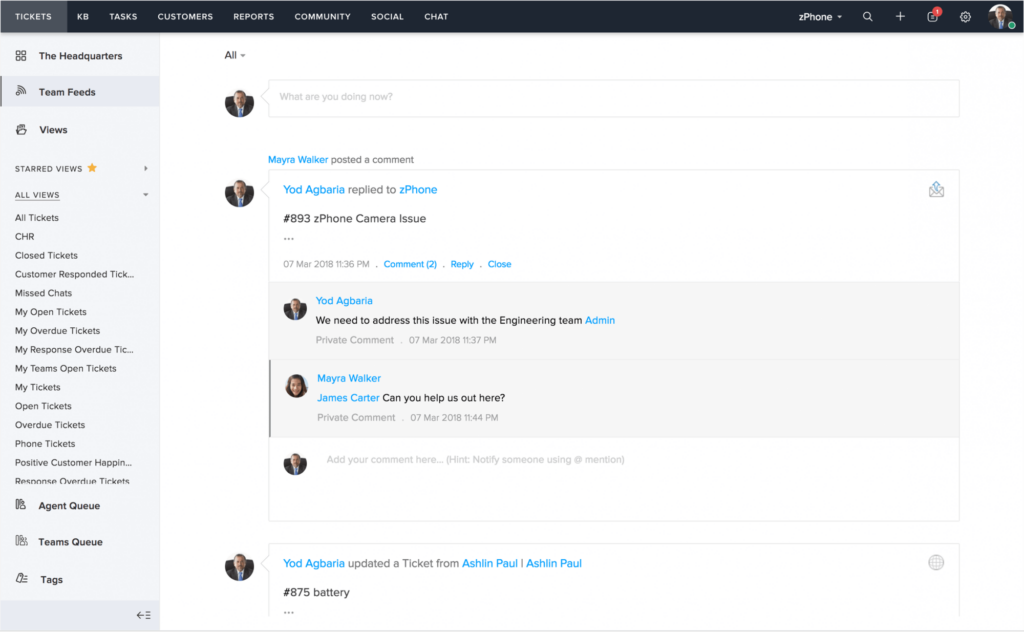
Everything from managing tickets to creating a knowledge base was pretty easy and intuitive. Zoho’s own self-service knowledge base portal is very helpful, and outlines most of the platform’s features in a clear and in-depth way.
Scalability
Zoho Desk is scalable, but functions best at the highest-level Enterprise plan. Core features a startup might need access to (live chat integration, AI automation) are restricted at the lower end of the scale.
It’s another helpdesk where your experience on higher- and lower-tier plans will be quite different. If you don’t intend to scale upwards, or if you’re starting out at the top level, this isn’t an issue. If you anticipate starting small and growing over time, on the other hand, it’s a less smooth experience.
Who Is It Best For?
Zoho Desk is a helpdesk designed for:
- Small businesses that want a cloud-based platform that’s easy to navigate and learn
- Enterprise users who want a large feature set, or SMB users who just need the absolute basics
8. Zendesk

The goal of Zendesk is to automate support as much as possible, allowing your agents to focus on more technical issues behind-the-scenes. It does a great job of compiling customer data, and presenting a comprehensive automated overview of tickets in a centralized inbox.
Zendesk has been around for a long time, and has a massive feature set. Because of this, it can also double as a CRM. On the other hand, what Zendesk offers in customization and advanced features is balanced by a less intuitive ‘out-of-the-box’ experience.
Key Features
- AI-powered bots to automatically resolve customer issues across all channels
- Generative AI tools for agents to expand, summarize, or change tone of text
- Automated resolutions (ARs) depending on plan and agent count
- Email (unlimited addresses), social media integration, web widget, and live chat
- Mobile SDKs for native support inside apps across iOS and Android
- Customized views of customer data and interaction history
- Custom workflows with pre-configuration based on best practices
- SLA management
- Advanced ticket routing
- Macros, triggers, automations, rule analysis and actionable next steps
- Analytics dashboards, including real-time live agent activity monitoring
User Experience
Zendesk can be complicated to navigate. That’s not due to poor design, but simply a result of its complexity and large feature set. It’s not a ‘set up quick and get started now’ solution.
Once you’re up and running, it’s not difficult to use. You just need to be willing to invest time and resources into optimizing it for your specific use cases. With plenty of customization options at your disposal, you can get it to do a lot of things.

On the other hand, if you don’t need all that functionality, it’s not as streamlined and simple to use on a day-to-day basis. It can be quite an adjustment if you’ve never used a helpdesk before.
Scalability
Zendesk is certainly scalable. Ultimately, however, it’s best for larger businesses with technical departments that can take full advantage of the many customization and feature options.
It’s also on the costly side. But you will get plenty of mid-tier features on the low-end plans, such as the AI agent, integration with social media channels, and reporting/analytics. Advanced AI features, including actionable insights and generative tools, come at an additional monthly cost per agent.
Who Is It Best For?
Zendesk tends to perform best for:
- Large businesses with complex support needs and a sizeable service team
- Companies that want to go all-in on automation, taking as many customer support tasks off their human agents as possible
- Businesses looking for access to a large feature set, and intending to make regular use of most of them
Choosing the Best Helpdesk Ticketing System for Your Small Business
Every business, regardless of size or niche, now has access to quality support software designed just for them. There’s a wide range of user-friendly options out there, covering just about every use case you might imagine.
In other words, there is a solution out there for your unique business. You just have to look for it. If none of the options on our list suit, there are plenty of alternatives to be found.
But if you happen to be a growth-focused small business, and you’re looking for a platform that balances ease of use and range of features, we’d encourage you to check out Groove! It’s designed and priced with businesses in mind, and our free trial lets your team test it out to see if it meets their needs.




